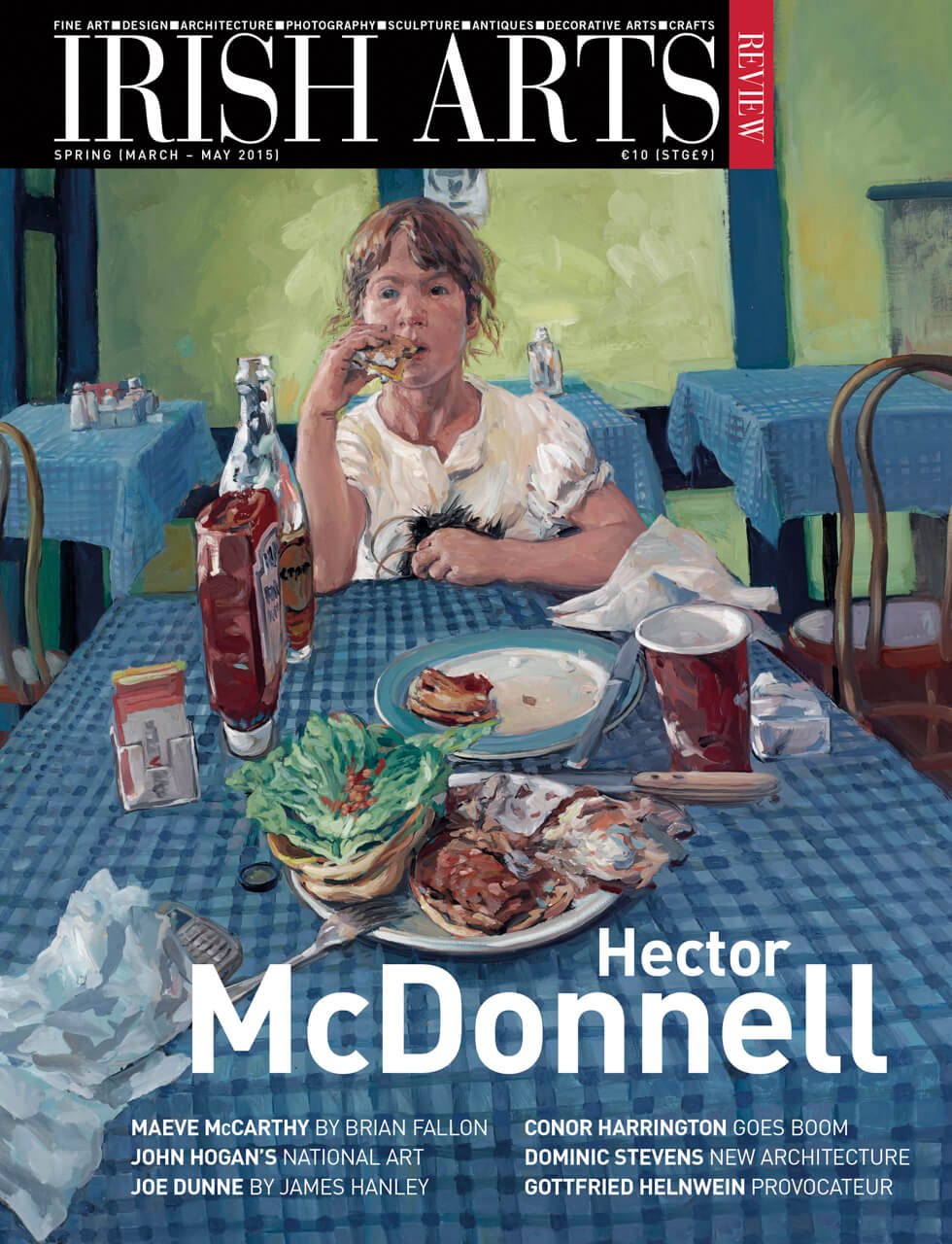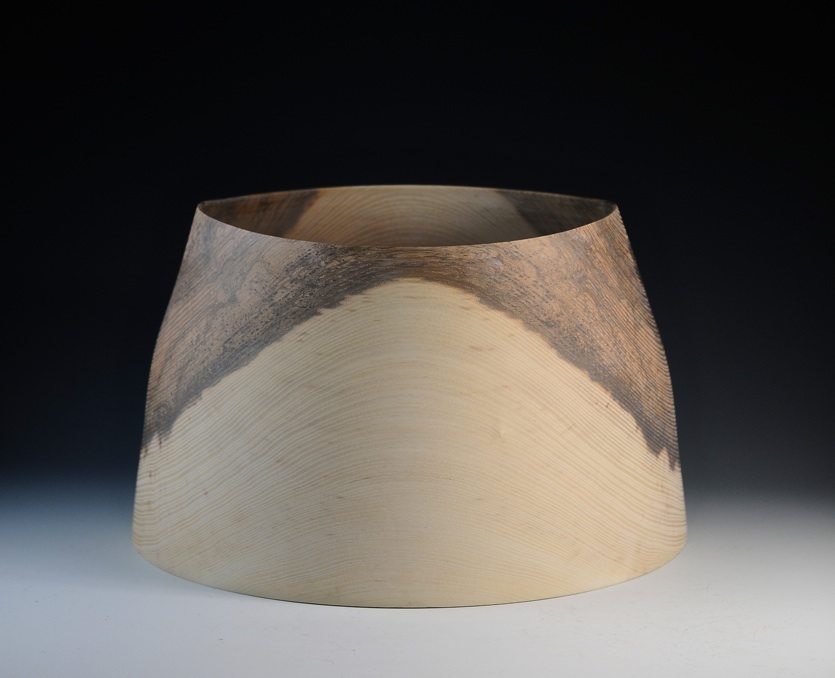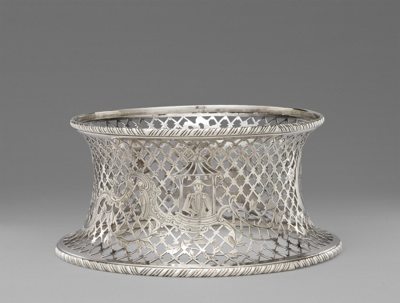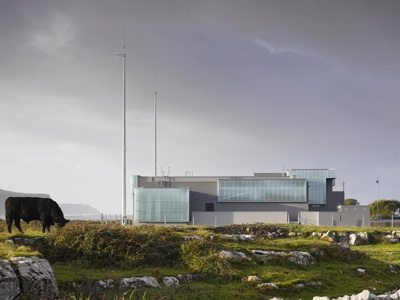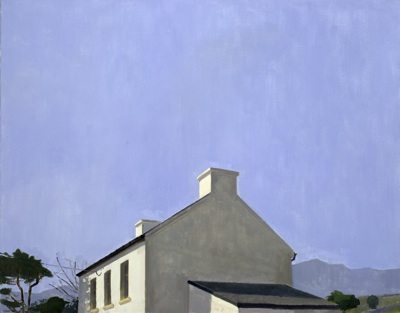
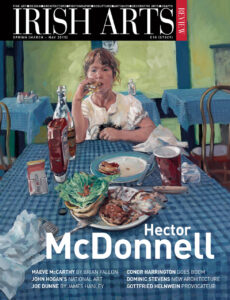
Maeve McCarthy looked set to become a portrait artist when circumstances intervened and other avenues beckoned, writes Brian Fallon.
Maeve McCarthy’s reputation has been a rather slow growth, but then so, in retrospect, has been her painting career overall. At one stage of it she painted portraits, and the now-familiar one of the late Maeve Binchy in the National Gallery did suggest, quite strongly, that this might be her future ‘line.’ Certain of her contemporaries apparently assumed that it was, and even spoke of her as potentially a prestige portraitist in future RHA exhibitions; she herself, however, saw things differently. The typical ‘image’ for which she is now best known consists of a kind of twilight zone of villages, small towns or, less commonly, isolated houses, seen very much as a night-driver might view them when they show up almost apparitionally under his or her headlights, and then are gone. (In fact her most recent exhibition, at the Catherine Hammond Gallery in Glengariff, was actually entitled ‘Approaching a Village’.)
These houses and buildings are generally depicted in a soft, slightly mysterious focus, which does not dissolve into actual vagueness. Are they intended to look intimate and welcoming, like some childhood or friend’s home, or are they alien and even slightly hostile? The artist herself does not rule out either of these reactions, but prefers to leave it to the individual viewer. Some buildings are shown in darknesss or semi-darkness, others have lighted windows, but as she says, these lit-up ones may be uninhabited. Isolated street lights occur too in the paintings, somehow accentuating the mood of nocturnal loneliness instead of banishing it. Telling little highlights and painterly subtleties keep the paint surfaces alive, rather than blank or inexpressive; the gradations between light, dark and twilight are also sensitively rendered. The scale of these pictures is generally small or smallish, though without being miniature. Instead of oils on canvas, they are usually painted in tempera on board primed with gesso, but of that, more later.
In the RHA exhibition last year, Maeve McCarthy exhibited six paintings, which, significantly, were sold more or less before the official opening (Figs 4&6). Two of these were actually marine pieces, or to be exact, one showed a small fishing craft cresting a dauntingly high wave while the other, by contrast, was a quiet harbour view in dusk. Her studio-cum-base, a rented farmhouse, is virtually at the foot of Mount Brandon, in Kerry, and accordingly she can observe the small pier on the coastline just below, where local craft come and go. These fishing boats, then, are very much part of her immediate environment, though she finds an extra, symbolic element in the tradition that it was from here that St Brendan set out on his great Atlantic voyage. This tradition is, of course, a very powerful one locally and is commemorated every year.
Her exhibitions at the Molesworth Gallery in Dublin had already brought her public notice as an interesting and individual figure in the recent wave of representational art, but with a style and subject matter very much her own. (Aidan Dunne, the respected art critic of the Irish Times, has given her discriminating praise.) She spends part of her time in Kerry and part in South Dublin, where she shares with her brother what had been their parental home, her father, a former ESB engineer aged 92, is now in a nursing home and her mother is recently dead. Driving up and down between these two bases, partly in order to ‘look after my Dad,’ she experiences willy-nilly the kind of visual and emotional sights/sensations embodied in her paintings. (The ‘crossroads at Castlegregory’, for instance, appear by now to mean something intimate and personal to her.) Yet it seems that the origins of such subject matter lie not primarily in the Irish landscape and its roadways but in America, where she has travelled and seen a great deal. In fact, one of her Molesworth Gallery exhibitions was actually entitled ‘Night and Day in America’ (Figs 1&2) and the catalogue carried an evocative foreword by her former partner, Kevin Kiely, a Fulbright Scholar in Literature for 2007-2008.
He recalled her travels in the mid-1990s through the American South-west, where she saw at first hand the kind of territory and landscape evoked in Zane Grey’s novels; Utah, Arizona and (especially) Colorado. This is the region, which, she says, is known to Americans as ‘the Four Corners.’ Not only did she live there for a time, she had her first two exhibitions locally but now tends to brush them aside as rather marginal in her career. It was during this phase that the ‘nocturnal’ basis of her style was largely formed; a much later visit took her through the Mid-West, as far as Idaho, and seemingly gave her many ideas for future works. Edward Hopper had became a strong influence and she makes no secret of it; her more recent and characteristic work, however, is far removed from Hopper’s New England starkness or his sometimes bleak, uncompromising light.
During all this she had kept in close contact with Ireland, and with Dublin in particular. Back home, a spell of working professionally for an animation studio left its mark and sharpened certain of her perceptions, but she continued to paint and won prizes in the RHA exhibitions. She was also a prizewinner in the Arnotts’ National Portrait competitions — now discontinued, and this opened up a possible new field, though a 2002 exhibition at the Frederick Gallery consisted mainly, and rather anti-climactically, of still-lifes. To judge from the catalogue, these (generally small) works were competent but unoriginal, with an occasional flavour of the American artist Georgia O’Keeffe. A 2006 showing was a much more accomplished and varied affair, with the Hopper influence still evident at times but not dominant; then came the ‘Night and Day’ already mentioned, and in 2010 the show entitled ‘Home’ which established her trade-mark subject matter. In this she appears to have established herself definitively, not only through depicting houses, roads and villages, but in her striking, spare, almost minimalist paintings and drawings of trees. (The Glengariff show included impressive examples of both, along with some big charcoal drawings, and apparently sold well.)
Ultimately, however, the core of Maeve McCarthy’s work does not lie so much in the subjects she paints, or even in her sensitivity to place and atmosphere, as in her perfectionist style and execution. She is an acutely, even obsessively technique-conscious painter, something which, of course, in itself is not a guarantee of creativity, but does at least give proof of genuine dedication. Earlier in her career she worked in oils, sometimes oils on board, but tempera is now, almost exclusively, the medium she employs. In America tempera painters have not been scarce over recent decades; Andrew Wyeth springs to mind straightaway, as do Ben Shahn, Mark Tobey, Morris Graves and Paul Cadmus. In Ireland, however, genuine tempera-users (excluding Patrick Pye, who belongs to an older generation) are remarkably thin in the ground and virtually the only fellow-practitioner she can call to mind is Joe Dunne (see our feature page 70) whose work she respects. It is a notably demanding medium, better suited on the whole to smallish, precisely-wrought pictures than to big ones.
McCarthy works as a rule on panels primed with gesso, a relatively traditional method (the van Eycks well may have worked that way, though probably adding some kind of oil glaze to a basically tempera body). Gesso, in her experience, is ‘too absorbent’ for oil paints and when combined inexpertly they can create a rather messy sludge, but the drier substance of tempera seems right for her and for her careful, allusive style. She layers the paint carefully, balancing ‘fat’ and ‘lean’, or cold tones against warm, and is very particular about her choice of paints. ‘Fifteen years ago I was experimenting a lot’, she says; however, that phase now seems in the past.
Though highly critical of aspects of her training at the NCAD, back in the 1980s, she remembers with gratitude certain essential skills taught to her by Carey Clarke. However, Maeve McCarthy still feels that the overall climate of that time was definitely against her, although she did have works accepted for two prominent group exhibitions, EVA and the Independent Artists. In retrospect, the freewheeling, slap-it-on modus operandi of the so-called New Expressionism, then dominant virtually everywhere, was deleterious both to her thinking and her working methods. It encouraged her to ‘paint big’ for a time, even when that was not at all her natural inclination. Much more serious in the long term, the absence of genuine guidance left her (and others like her) with little sense of direction or even much self-belief, a predicament which it took decades to overcome; in fact, there were even periods in which she virtually stopped painting.
It is only in her middle years that she has found her own, unique groove and feels at ease inside it. And while she experiences no kinship with conceptualism – or is that phase of art by now played out? – she insists that there is a basic concept underlying what she has achieved, though it is an elusive one to put into words. Tentatively I would suggest the label ‘poetic realism’ or, alternatively, ‘painterly realism’, a term made fashionable in America by Fairfield Porter, Jane Freilicher and others, but never used here. Is it not about time it was given some real currency in Ireland, which would seen a natural home for the sensibility it evokes?
Brian Fallon is a regular contributor to the Irish Arts Review.
From the IAR Archive
First published in the Irish Arts Review Vol 32, No 1, 2015
